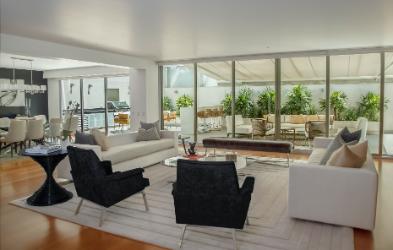The art of altering rooms extends beyond just aesthetics in the field of business interior design. It is a meticulously organised symphony of styles that complements the distinct needs and identities of many sectors. Each context necessitates a particular design approach, from the structured and collaborative spaces of office interior design to the immersive and appealing ambiance of restaurant interior design. In this investigation, we uncover the critical significance of business interior design in shaping experiences across industries.
The modern workplace, like the concept of office interior design, is evolving. The days of neutral cubicles and mundane colour schemes are over. Offices are now envisioned as dynamic settings that encourage cooperation, innovation, and employee well-being. Office interior design has a significant impact on productivity, creativity, and general work culture.
The emphasis in modern office interior design is on creating shared workspaces that stimulate contact and idea sharing. Open floor patterns, open areas, and shared resources all represent a shift towards a more inclusive and team-oriented work culture. Colour strategy, flexible furniture, and natural light all contribute to a cheerful and energising ambiance that promotes both focus and collaboration.

Biophilic design elements are becoming increasingly prevalent in office interior designs. Bringing nature into the workplace by incorporating plants, natural materials, and plenty of natural light has been found to improve employee well-being, reduce stress, and boost productivity. Biophilic design in workplace environments demonstrates the rising recognition of the significant relationship between the environment and human performance.
The modern workforce emphasises flexibility, and adaptable layouts and multipurpose rooms reflect this in workplace interior design. Flexible furniture, movable walls, and modular design features enable simple reconfiguration to meet changing needs and evolving work dynamics. This adaptability is critical in designing a workstation that can accommodate the various duties and activities that occur in an office setting.

Restaurant interiors, unlike corporate settings, serve as a canvas for culinary experiences and brand narrative. A restaurant's design sets the tone for the entire eating experience, influencing customer impressions and adding to the establishment's own character.
A restaurant's ambiance is an important part of its interior design. The choice of colours, lighting, and furniture sets the tone for the dining experience, whether it's a cosy cafe, a fashionable bistro, or a fine-dining restaurant. A romantic restaurant may use warm colours, dark lighting, and plush seats, whilst a casual brunch establishment may use brilliant colours, natural light, and community tables.
The layout of a restaurant is critical in ensuring a smooth flow for both guests and staff. Efficient space planning ensures that the kitchen, dining area, and service zones all operate together in harmony. The location of tables, booths, and waiting rooms is important in creating a pleasant and memorable dining experience. Quick service and easy navigation are essential in fast-paced places such as cafes, whereas fine-dining restaurants may emphasise on creating intimate dining enclaves.
Restaurant interior design is an effective technique for communicating brand identity. The aesthetic selections, decor features, and overall mood should be consistent with the concept and values of the restaurant. A rustic-themed restaurant might have reclaimed wood, industrial lighting, and earthy tones, whereas a modern sushi bar might have sleek lines, minimalist design, and an emphasis on craftsmanship. Design consistency contributes to the development of a powerful and memorable brand image.

As the distinction between work and play becomes increasingly blurred, a new trend has emerged: the merging of co-working spaces and restaurant cafes. These hybrid spaces cater to the needs of remote workers, freelancers, and entrepreneurs by providing a unique blend of productivity and relaxation.
Co-working cafés mix the lively atmosphere of a busy cafe with the practical components of a modern office. The design of these rooms must strike a fine balance between creating an active and convivial environment and providing the required infrastructure for work. Individuals looking for a flexible and inspirational work atmosphere will like the comfortable seats, high-speed internet, and dedicated work zones.
Co-working cafes are designed to be flexible, with individuals able to select between collaborative areas, quiet corners, and communal work tables. The utilisation of adjustable furniture, movable dividers, and a combination of natural and artificial lighting produces a setting that can accommodate a wide range of work preferences and styles. This combination of design components meets the changing needs of today's workforce.
Offices and restaurants play separate but equally important roles in the symphony of commercial interior design. The design of workplace spaces influences how we work by encouraging cooperation, creativity, and adaptability. Restaurant interiors, on the other hand, set the tone for gastronomic encounters by creating a tale that extends beyond the plate. The convergence of these forms in coworking cafes reflects the changing nature of work, where flexibility and comfort are essential.